Engage NY Eureka Math Geometry Module 1 Lesson 18 Answer Key
Eureka Math Geometry Module 1 Lesson 18 Example Answer Key
Example 1.
Why is the phrase in the plane critical to the definition of parallel lines? Explain and illustrate your reasoning.
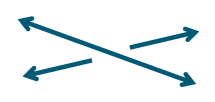
Answer:
Two lines in (3-dimensional space) are called skew lines if they do not lie in the same plane. In that case, they do not intersect (because if they did, they would share a plane together) and are not parallel. (If they were parallel, then they would both have to lie in the same plane.)
In Lesson 7, we recalled some basic facts learned in earlier grades about pairs of lines and angles created by a transversal to those lines. One of those basic facts is the following:
Suppose a transversal intersects a pair of lines. The lines are parallel if and only if a pair of alternate interior angles are equal in measure.
Our goal in this lesson is to prove this theorem using basic rigid motions, geometry assumptions, and a geometry assumption we introduce in this lesson called the parallel postulate. Of all of the geometry assumptions we have given so far, the parallel postulate gets a special name because of the special role it played in the history of mathematics. (Euclid included a version of the parallel postulate in his books, and for 2,000 years people tried to show that it was not a necessary assumption. Not only did it turn out that the assumption was necessary for Euclidean geometry, but study of the parallel postulate led to the creation of non-Euclidean geometries.)
The basic fact above really has two parts, which we prove separately:
1. Suppose a transversal intersects a pair of lines. If two alternate interior angles are equal in measure, then the pair of lines are parallel.
2. Suppose a transversal intersects a pair of lines. If the lines are parallel, then the pair of alternate interior angles are equal in measure.
The second part turns out to be an equivalent form of the parallel postulate. To build up to the theorem, first we need to do a construction.
Example 2.
Given a line l and a point P not on the line, follow the steps below to rotate l by 180° to a line l’ that passes through P:
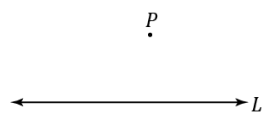
a. Label any point A on l.
b. Find the midpoint of segment AP using a ruler. (Measure the length of segment AP, and locate the point that is distance \(\frac{A P}{2}\) from A between A and P.) Label the midpoint C.
c. Perform a 180° rotation around center C. To quickly find the image of 𝒍 under this rotation by hand:
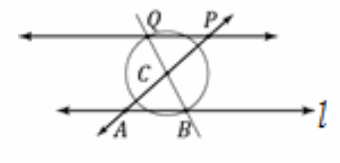
i. Pick another point B on l.
ii. Draw \(\overleftrightarrow{\boldsymbol{C B}} \text { . }\)
iii. Draw circle: center C, radius CB.
iv. Label the other point where the circle intersects \(\overleftrightarrow{C B}\) by Q.
v. Draw \(\overleftrightarrow{P Q}\).
d. Label the image of the rotation by 180° of l by l’=RC,180(l).
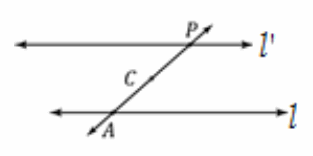
How does your construction relate to the geometry assumption stated above to rotations? Complete the statement below to clarify your observations:
RC,180 is a 180° ___ around C. Rotations preserve ___; therefore RC,180, maps the line l to the line __. What is RC,180(A)? ___
Answer:
RC,180 is a 180° rotation around C. Rotations preserve lines; therefore RC,180, maps the line l to the line l’. What is RC,180(A)? P
Example 3.
The lines l and l’ in the construction certainly look parallel, but we do not have to rely on looks.
Claim: In the construction, l is parallel to l’ .
PROOF: We show that assuming they are not parallel leads to a contradiction. If they are not parallel, then they must intersect somewhere. Call that point X. Since X is on l’, it must be the image of some point S on l under the RC,180 rotation (i.e., RC,180(S)=X). Since RC,180 is a 180° rotation, S and X must be the endpoints of a diameter of a circle that has center C. In particular, \(\overleftrightarrow{\boldsymbol{S X}}\) must contain C. Since S is a point on l, and X is a different point on l (it was the intersection of both lines), we have that l=\(\overleftrightarrow{\boldsymbol{S X}}\) because there is only one line through two points. But \(\overleftrightarrow{\boldsymbol{S X}}\) also contains C, which means that l contains C. However, C was constructed so that it was not on l. This is absurd.
There are only two possibilities for any two distinct lines l and l’ in a plane: either the lines are parallel, or they are not parallel. Since assuming the lines were not parallel led to a false conclusion, the only possibility left is that l and l’
were parallel to begin with.
Example 4.
The construction and claim together implies the following theorem.
THEOREM: Given a line l and a point P not on the line, then there exists line l’ that contains P and is parallel to l.
This is a theorem we have justified before using compass and straightedge constructions, but now we see it follows directly from basic rigid motions and our geometry assumptions.
Example 5.
We are now ready to prove the first part of the basic fact above. We have two lines, l and l’, and all we know is that a transversal \(\overleftrightarrow{\boldsymbol{A B}}\) intersects l and l’ such that a pair of alternate interior angles are equal in measure. (In the picture below, we are assuming m∠QPA=m∠BAP.)
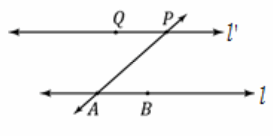
Let C be the midpoint of \(\overline{A P}\). What happens if you rotate 180° around the center C? Is there enough information to show that RC,180(l)=l’?
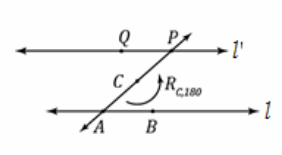
a. What is the image of the segment AP?
Answer:
PA
b. In particular, what is the image of the point A?
Answer:
P
c. Why are the points Q and RC,180(B) on the same side of \(\overleftrightarrow{\boldsymbol{A P}}\)?
Answer:
Sketch of the Answer: The rotation by 180° maps \(\overleftrightarrow{\boldsymbol{A P}}\) to itself because \(\overleftrightarrow{\boldsymbol{A P}}\) contains the center C. In particular, it can be shown that the rotation maps one half-plane of \(\overleftrightarrow{\boldsymbol{A P}}\) to the other half-plane and vice versa. Since Q and B are in opposite half-planes (by definition of alternate interior angles), and B and RC,180(B) are in opposite half-planes, Q and RC,180(B) must be in the same half-plane.
d. What is the image of RC,180(∠BAP)? Is it ∠QPA? Explain why.
Answer:
Because under the rotation, the vertex of ∠BAP maps to the vertex of ∠QPA, ray AP maps to ray PA, the point B goes to the same side as Q. Since m∠BAP=m∠QPA (by assumption), ray AB must map to ray PQ. Thus, ∠BAP maps to ∠QPA.
e. Why is RC,180(l)=l’?
Answer:
Since \(\overrightarrow{A B}\) maps to \(\overrightarrow{P Q}\), RC,180 (l)=RC,180(\(\overleftrightarrow{\boldsymbol{A B}}\)))=\(\overleftrightarrow{\boldsymbol{P Q}}\)=l’.
We have just proven that a rotation by 180° takes l to l’. By the claim in Example 3, lines l and l’ must be parallel, which is summarized below.
THEOREM: Suppose a transversal intersects a pair of lines. If a pair of alternate interior angles are equal in measure, then the pair of lines are parallel.
Discussion
In Example 5, suppose we had used a different rotation to construct a line parallel to l that contains P. Such constructions are certainly plentiful. For example, for every other point D on l, we can find the midpoint of segment PD and use the construction in Example 2 to construct a different 180° rotation around a different center such that the image of the line l is a parallel line through the point P. Are any of these parallel lines through P different? In other words,
Can we draw a line other than the line l’ through P that never meets l?
The answer may surprise you; it stumped mathematicians and physicists for centuries. In nature, the answer is that it is sometimes possible and sometimes not. This is because there are places in the universe (near massive stars, for example) where the model geometry of space is not plane-like or flat but is actually quite curved. To rule out these other types of strange but beautiful geometries, we must assume that the answer to the previous question is only one line. That choice becomes one of our geometry assumptions:
(Parallel Postulate) Through a given external point there is at most one line parallel to a given line.
In other words, we assume that for any point P in the plane not lying on a line l, every line in the plane that contains P intersects l except at most one line—the one we call parallel to l.
Example 6.
We can use the parallel postulate to prove the second part of the basic fact.
THEOREM: Suppose a transversal intersects a pair of lines. If the pair of lines are parallel, then the pair of alternate interior angles are equal in measure.
PROOF: Suppose that a transversal \(\overleftrightarrow{\boldsymbol{A P}}\) intersects line l at A and l’ at P, pick and label another point B on l, and choose a point Q on l’ on the opposite side of \(\overleftrightarrow{\boldsymbol{A P}}\) as B. The picture might look like the figure below:

Let C be the midpoint of \(\overline{A P}\), and apply a rotation by 180° around the center C. As in previous discussions, the image of l is the line RC,180(l), which is parallel to l and contains point P. Since l’ and RC,180(l) are both parallel to l and contain P, by the parallel postulate, they must be the same line: RC,180(l)=l’ . In particular, RC,180(∠BAP)=∠QPA. Since rotations preserve angle measures, m∠BAP=m∠QPA, which was what we needed to show.
Discussion
It is important to point out that, although we only proved the alternate interior angles theorem, the same sort of proofs can be done in the exact same way to prove the corresponding angles theorem and the interior angles theorem. Thus, all of the proofs we have done so far (in class and in the Problem Sets) that use these facts are really based, in part, on our assumptions about rigid motions.
Example 7.
We end this lesson with a theorem that we just state but can be easily proved using the parallel postulate.
THEOREM: If three distinct lines l1, l2, and l3 in the plane have the property that l1 || l2 and l2 || l3, then l1 || l3. (In proofs, this can be written as, “If two lines are parallel to the same line, then they are parallel to each other.”)
Note that students should at least remember that, in Euclidean Geometry, two lines are parallel if and only if alternate interior angles of any transversal are equal in measure and should be able to elaborate on what that means. This one statement includes both the parallel postulate and its converse. We can construct parallel lines without the parallel postulate, but in a geometry that does not satisfy the parallel postulate; there are many parallels to a given line through a point not on it. Without the parallel postulate, parallel lines are plentiful, and we cannot tell much about a line if all we know is that it passes through a point and is parallel to another line.
Eureka Math Geometry Module 1 Lesson 18 Exercise Answer Key
Opening Exercise
Exchange Problem Sets from Lesson 17 with a classmate. Solve the problems posed by your classmate while he or she solves yours. Compare your solutions, and then discuss and resolve any discrepancies. Why were you asked only to locate the point of rotation rather than to rotate a pre-image to obtain the image? How did you use perpendicular bisectors in constructing your solutions?
Answer:
Answers will vary.
Discussion
We say that two lines are parallel if they lie in the same plane and do not intersect. Two segments or rays are parallel if the lines containing them are parallel.
Eureka Math Geometry Module 1 Lesson 18 Problem Set Answer Key
Notice that we are frequently asked two types of questions about parallel lines. If we are told that two lines are parallel, then we may be required to use this information to prove the congruence of two angles (corresponding, alternate interior, etc.). On the other hand, if we are given the fact that two angles are congruent (or perhaps supplementary), we may have to prove that two lines are parallel.
Question 1.
In the figure, \(\overline{A L}\) || \(\overline{B M}\), \(\overline{A L}\)⊥\(\overline{C F}\), and \(\overline{G K}\)⊥\(\overline{B M}\). Prove that \(\overline{C F}\) || \(\overline{G K}\).
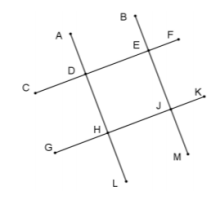
Answer:
\(\overline{A L}\) || \(\overline{B M}\) Given
\(\overline{A L}\)⊥\(\overline{C F}\) Given
\(\overline{G K}\)⊥\(\overline{B M}\) Given
m∠ADC=90° Definition of perpendicular lines
m∠BJH=90° Definition of perpendicular lines
m∠BJH=m∠AHG If two parallel lines are cut by a transversal, then the corresponding angles are equal in measure.
m∠ADC=m∠AHG Substitution property of equality
\(\overline{C F}\) || \(\overline{G K}\) If two lines are cut by a transversal such that the corresponding angles are equal in measure, then the lines are parallel.
Question 2.
Given that ∠B and ∠C are supplementary and m∠A=m∠C, prove that \(\overline{A D}\) || \(\overline{B C}\).
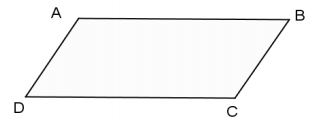
Answer:
∠B and ∠C are supplementary. Given
m∠A=m∠C Given
m∠B+m∠C=180 Definition of supplementary angles
m∠B+m∠A=180 Substitution property of equality
\(\overline{A D}\) || \(\overline{B C}\) If a transversal intersects two lines such that the same side interior angles are supplementary, then the lines are parallel.
Question 3.
Mathematicians state that if a transversal to two parallel lines is perpendicular to one of the lines, then it is perpendicular to the other. Prove this statement. (Include a labeled drawing with your proof.)

Answer:
\(\overline{A L}\) || \(\overline{B M}\) Given
\(\overline{A L}\) ⊥ \(\overline{C F}\) Given
m∠ADC=90° Definition of perpendicular lines
m∠ADC=m∠BED If two parallel lines are cut by a transversal, then corresponding angles are equal in measure.
m∠BED=90° Substitution
\(\overline{C F}\) ⊥\(\overline{B M}\) Definition of perpendicular lines
Question 4.
In the figure, \(\overline{A B}\) || \(\overline{C D}\) and \(\overline{E F}\) || \(\overline{G H}\) . Prove that m∠AFE=m∠DKH.
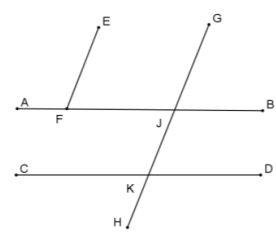
Answer:
\(\overline{A B}\) || \(\overline{C D}\) Given
\(\overline{E F}\) || \(\overline{G H}\) Given
m∠AFE=m∠GJF If two parallel lines are cut by a transversal, then the corresponding angles are equal in measure.
m∠JKC=m∠GJF If two parallel lines are cut by a transversal, then the corresponding angles are equal in measure.
m∠JKC=m∠DKH Vertical angles are equal in measure.
m∠AFE=m∠DKH Transitive property
Question 5.
In the figure, ∠E and ∠AFE are complementary, and ∠C and ∠BDC are complementary. Prove that \(\overline{A E}\) || \(\overline{C B}\) .

Answer:
∠E and ∠AFE are complementary. Given
∠C and ∠BDC are complementary. Given
m∠E+m∠AFE=90° Definition of complementary angles
m∠C+m∠BDC=90° Definition of complementary angles
m∠E+m∠AFE+m∠A=180° Sum of the angle measures in a triangle is 180°.
m∠C+m∠BDC+m∠B=180° Sum of the angle measures in a triangle is 180°.
m∠A=90°; m∠=90° Subtraction property of equality
m∠A=m∠B Substitution property of equality
\(\overline{A E}\) || \(\overline{C B}\) If two lines are cut by a transversal such that a pair of alternate interior angles are equal in measure, then the lines are parallel.
Question 6.
Given a line l and a point P not on the line, the following directions can be used to draw a line m perpendicular to the line l through the point P based upon a rotation by 180°:
a. Pick and label a point A on the line l so that the circle (center P, radius AP) intersects l twice.
b. Use a protractor to draw a perpendicular line n through the point A (by constructing a 90° angle).
c. Use the directions in Example 2 to construct a parallel line m through the point P.
Do the construction. Why is the line m perpendicular to the line l in the figure you drew? Why is the line m the only perpendicular line to l through P?
Answer:
Figures will vary but should follow the directions outlined.
Students can use Problem 3 or reprove the fact that if a transversal to two parallel lines is perpendicular to one, then it is perpendicular to the other.
Suppose line m’ contains P and is perpendicular to l; then by the interior angles theorem (or alternate interior angles or corresponding interior angles), m’ is parallel to n. Since m and m’are both parallel to n and contain P, by the parallel postulate, they must be the same line (i.e., m’=m).
A student might answer, “parallel postulate.” If so, partial credit might be awarded (depending on your tastes for partial credit).
Problems 7–10 all refer to the figure to the right. The exercises are otherwise unrelated to each other.
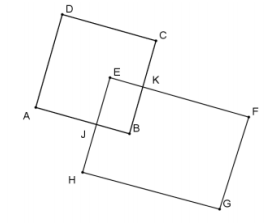
Question 7.
\(\overline{A D}\) || \(\overline{B C}\) and ∠EJB is supplementary to ∠JBK. Prove that \(\overline{A D}\) || \(\overline{J E}\).
Answer:
\(\overline{A D}\) || \(\overline{B C}\) Given
∠EJB is supplementary to ∠JBK. Given
\(\overline{E J}\) || \(\overline{B C}\) If a transversal intersects two lines such that the same side interior angles are supplementary, then the lines are parallel.
\(\overline{A D}\) || \(\overline{E J}\) If two segments are parallel to the same segment, then they are parallel to each other.
Question 8.
\(\overline{A D}\) || \(\overline{F G}\) and \(\overline{E J}\) || \(\overline{F G}\). Prove that ∠DAJ and ∠EJA are supplementary.
Answer:
\(\overline{A D}\) || \(\overline{F G}\) Given
\(\overline{E J}\) || \(\overline{F G}\) Given
\(\overline{A D}\) || \(\overline{E J}\) If two segments are parallel to the same segment, then they are parallel to each other.
m∠DAJ+m∠EJA=180° If a transversal intersects two parallel lines, then the interior angles on the same side of the transversal are supplementary.
Question 9.
m∠C=m∠G and ∠B is supplementary to ∠G. Prove that \(\overline{D C}\) || \(\overline{A B}\) .
Answer:
m∠C=m∠G Given
∠B is supplementary to ∠G Given
m∠B+m∠G=180° Definition of supplementary angles
m∠B+m∠C=180° Substitution property of equality
\(\overline{D C}\) || \(\overline{A B}\) If a transversal intersects two lines such that the same side interior angles are supplementary, then the lines are parallel.
Question 10.
\(\overline{A B}\) || \(\overline{E F}\) , \(\overline{E F}\) ⊥\(\overline{C B}\) , and ∠EKC is supplementary to ∠KCD. Prove that \(\overline{A B}\) || \(\overline{D C}\) .
Answer:
\(\overline{A B}\) || \(\overline{E F}\) Given
\(\overline{E F}\) ⊥ \(\overline{C B}\) Given
∠EKC is supplementary to ∠KCD. Given
m∠ABC+m∠BKE=180° If parallel lines are cut by a transversal, then interior angles on the same side are supplementary.
m∠EKC+m∠KCD=180° Definition of supplementary angles
m∠BKE=90° and m∠EKC=90° Definition of right angles
m∠ABC=90° and m∠KCE=90° Subtraction property of equality
∠ABC and ∠KCE are supplementary. Definition of supplementary angles
\(\overline{A B}\) || \(\overline{D C}\) If two lines are cut by a transversal such that a pair of interior angles on the same side are supplementary, then the lines are parallel.
Eureka Math Geometry Module 1 Lesson 18 Exit Ticket Answer Key
Question 1.
Construct a line through the point P below that is parallel to the line l by rotating l by 180° (using the steps outlined in Example 2).

Answer:
The construction should look like the steps in Example 2.
Question 2.
Why is the parallel line you constructed the only line that contains P and is parallel to l?
Answer:
The answer should reference the parallel postulate in a meaningful way.